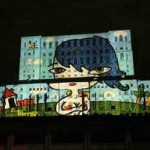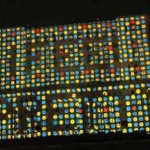In the early 1990s, everyone thought that we could get rid of the House of the People. But some proposals, like to demolish it partially or completely, to bury it under a hill, etc, seemed utopian even then. In fact, it is impossible to destroy it, and actually, it is about an economic value that is supposed to be used. Moreover, maybe it is much better to assume your own history, even its ugliness, than to wipe it off. Nevertheless, I think that few could imagine back then what was really to become of this monster. No one would have thought that both Houses of Parliament would move in and the project would be completed by the very same designer.
Well, it did happen. If the great axis changes as an effect of random actions, from glazed in balconies, garish signs and huge banners, to the complete alteration of the facades, the House will stay as a self-contained fortress, in which the intervention resulting in the National Museum of Contemporary Art is almost untraceable within the monolithic unity and hermetic composition of the ensemble.
This ogre-like monstrosity becomes humane whenever in the square or in the park in front of it concerts or beer festivals take place. Then the building is just an ordinary background for the hustle and bustle surrounding it. However, such events do not come even near the object proper, and the underlying contradictions do not cancel the sheer ugliness of the ensemble. This is why I was a bit sceptical when I went to Urban Art – the projection series whose curator was Marilena Oprescu (Artmix) during the night of September 22-23. I was wrong and I got a real aesthetical shock. The mixture of “hard” projections from the work of established contemporary artists or wild graphic artists and that pompous facade is simply smashing. The blurring effect of scale between the projections and the architectural elements is specific to such actions, and always cast a different light on both the building and the projected art. However, this time the contradictions almost lead to sublime. The kitsch, megalomaniacal monolith is broken, composed anew from images and its significations are cancelled in a quiet comfortable manner. I think that projecting such images on a permanent basis would humanize the House. I can imagine it claiming “I feel pretty” (as in Cosmin Moldovan’s projection) and calling the enthralled people’s and tourists’ attention that things might not be so. Some ivy on the facade (as Marilena Oprescu and Mircea Maieru proposed) – why not? Eventually, some other changes might occur like alterations of functions and facade, insertion of really public functions, tearing down of the wall and its swallowing by the city. The House of the People as a spunky and accessible urban fragment! What a nice thing to do and what a profitable way to put an end to Ceausescu’s mark over the Romanian cultural imagination.
Curator: Marilena Oprescu, “Artmix” Cultural Association
Text: Stefan Ghenciulescu
Photo: Mircea Maieru



